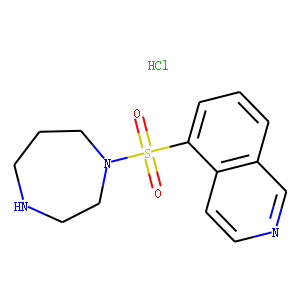| Reference | 1. Acta Neurochir (Wien). 1999;141(1):13-9.
<br>
Intra-arterial infusion of fasudil hydrochloride for treating vasospasm following
subarachnoid haemorrhage.
<br>
Tachibana E(1), Harada T, Shibuya M, Saito K, Takayasu M, Suzuki Y, Yoshida J.
<br>
Author information: <br>
(1)Department of Neurosurgery, Nagoya University School of Medicine, Japan.
<br>
In this pilot study we treated cerebral vasospasm in patients with subarachnoid
haemorrhage to assess intra-arterial fasudil hydrochloride. We analysed effects
of intra-arterial infusion on angiographically evident cerebral vasospasm in 10
patients including 3 with symptoms of vasospasm. Over 10 to 30 min 15 to 60 mg
was administered via the proximal internal carotid artery or vertebral artery
following standard angiography, without superselective techniques. A total of 24
arterial territories (21 internal carotid, 3 vertebral) were treated.
Angiographic improvement of vasospasm was demonstrated in 16 arterial territories
(local dilation in 2, diffuse dilation in 14) in 9 patients. In 2 symptomatic
patients, intra-arterial fasudil hydrochloride was associated with resolution of
symptoms without sequelae. In the third symptomatic patient the benefit of
fasudil hydrochloride was only temporary, and a large cerebral infarction
occurred. All asymptomatic patients showed no progression of angiographic to
symptomatic vasospasm after treatment with intra-arterial fasudil hydrochloride.
No adverse effect was encountered.
<br><br>
2. Neurol Med Chir (Tokyo). 1998 Dec;38(12):805-10; discussion 810-1.
<br>
Combination therapy of fasudil hydrochloride and ozagrel sodium for cerebral
vasospasm following aneurysmal subarachnoid hemorrhage.
<br>
Nakashima S(1), Tabuchi K, Shimokawa S, Fukuyama K, Mineta T, Abe M.
<br>
Author information: <br>
(1)Department of Neurosurgery, Saga Medical School, Japan.
<br>
Fasudil hydrochloride is a new type of intracellular calcium antagonist,
different from the calcium entry blockers that are commonly employed for clinical
use. Since September 1995, the combination of fasudil hydrochloride and ozagrel
sodium, an inhibitor of thromboxane A2 synthesis, has been used to treat 60
patients at risk of cerebral vasospasm after aneurysmal subarachnoid hemorrhage.
The effectiveness of this combination therapy was investigated by comparison with
the outcome of 57 patients previously treated with only ozagrel sodium. The
combination therapy was significantly more effective (p < 0.01) in reducing the
incidence of low density areas on computed tomography scans, and reduced, but not
significantly, the occurrence of symptomatic vasospasm. The combination therapy
of fasudil hydrochloride and ozagrel sodium has superior effectiveness over only
ozagrel sodium in treating patients at risk of vasospasm after aneurysmal
subarachnoid hemorrhage.
<br><br>
3. FEBS Lett. 1998 Feb 6;422(3):363-7.
<br>
Inhibition of HIV-1 Nef-induced apoptosis of uninfected human blood cells by
serine/threonine protein kinase inhibitors, fasudil hydrochloride and M3.
<br>
Okada H(1), Takei R, Tashiro M.
<br>
Author information: <br>
(1)Department of Virology 1, National Institute of Infectious Diseases, Tokyo,
Japan.
<br>
The Nef protein of HIV-1 binds to and induces apoptotic cytolysis of uninfected
but activated human peripheral blood mononuclear cells (PBMC) and various cell
line cells derived from CD4+ T, CD8+ T and B lymphocytes, macrophages, and
neutrophils. The Nef-induced apoptosis also occurs with blood cells not
expressing CD95 (Fas). The Nef-induced apoptosis as well as Fas-mediated
apoptosis was inhibited by acetyl-Try-Val-Ala-Asp-CHO, an IL-1beta converting
enzyme (ICE) inhibitor. On the other hand, serine/threonine protein kinase (PK)
inhibitors, H-7, fasudil hydrochloride and M3, inhibited the Nef-induced
apoptosis, and not the Fas-mediated one, without affecting the cell-binding
activity of Nef and Nef-binding capacity of the activated cells. Preincubation of
the cells with the drugs before being bound by Nef was required for the
inhibition of apoptosis. These results suggest that the PK inhibitors
specifically act on a cellular protein involved in the upper stream of signal
transduction pathway of the Nef-induced apoptosis, which is different from the
Fas-mediated pathway but meets it upstream of ICE. In addition, the drugs
suppressed the cellular activation-associated cell surface expression of a
putative Nef-binding protein in PBMC, although they had no influence on its
expression in cell line cells. These findings suggest the feasibility of clinical
use of the PK inhibitors to prevent the development of AIDS by inhibiting the
Nef-induced apoptosis of uninfected blood cells.
<br><br>
4. Clin Neuropharmacol. 1993 Dec;16(6):501-10.
<br>
Effects of fasudil hydrochloride on cerebral blood flow in patients with chronic
cerebral infarction.
<br>
Nagata K(1), Kondoh Y, Satoh Y, Watahiki Y, Yokoyama E, Yuya H, Hirata Y,
Shishido F, Hatazawa J, Kanno I, et al.
<br>
Author information: <br>
(1)Department of Neurology, Research Institute for Brain and Blood Vessels,
Akita, Japan.
<br>
To evaluate the effect of the novel intracellular calcium antagonist fasudil
hydrochloride, cerebral blood flow (CBF) was measured quantitatively with
positron emission tomography following the intravenous administration of fasudil
in five patients with chronic cerebral infarction. The hemispheric mean CBF
increased significantly on both hemispheres 30, 60, and 90 min after the
administration of fasudil when the CBF values were corrected according to PaCO2
level, although there was no significant change in raw CBF data. A significant
increase of CBF was seen in the cerebellar hemisphere and thalamus at 30 min and
in the occipital cortex at 90 min. There was no significant fall in the systemic
blood pressure after the administration of fasudil.
<br>
|

